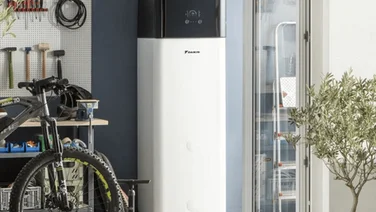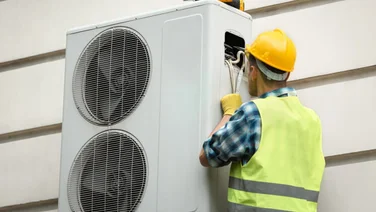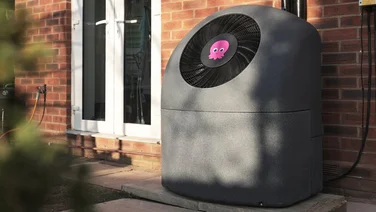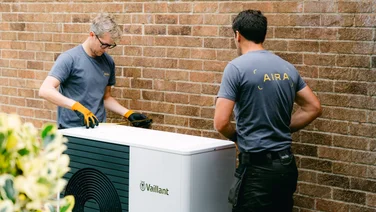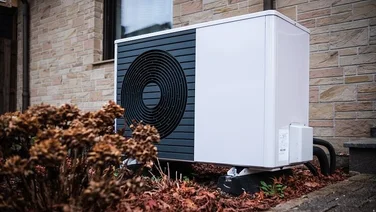- Portable heat pumps can provide heating or cooling for a single room
- They are around three times more efficient than electric radiators
- On average, they cost between £250 and £800
Portable heat pumps cost less than full-sized ones, and can be a great, low-carbon option for heating an individual room.
We’ll go over exactly what portable heat pumps are, how they work, and how much they cost in this article. We’ll explain what contexts they’re typically used in, and give you our verdict on whether they’re worth it.
Interested in getting a heat pump that can heat your whole house? We can put you in touch with professional heat pump installers. Just fill in our quick form, and we’ll pass your details onto our network of installers, who’ll offer you their best prices.
What type of central heating do you currently use?
Get started
What are portable heat pumps?
Portable heat pumps, sometimes called ‘portable air conditioners with heating’, are small, portable air-to-air heat pumps that can be used to heat or cool a room, but not a whole house.
Crucially, they’re plug-in models, which means they don’t require professional installation.
They typically consist of a singular unit, one or two exhaust hoses, and sometimes a drain pipe.
How do portable heat pumps work?
Portable heat pumps work by drawing in warmth from the outside air, heating it up further with a refrigerant, and blowing hot air back into the room. This is the same process that full-sized air-to-air heat pumps use.
In air-conditioning mode, the process is similar, only the heat pump cools the air instead of heating it.
To use a portable heat pump, it needs to be placed near a slightly open window, out which the exhaust hose (or hoses), and drain pipe (if there is one) can hang. The unit usually comes with panels that can be attached to the window to cover the remaining open space.
Types of portable heat pumps
There are two main types of portable heat pump: single hose and dual hose.
Single hose portable heat pumps have one exhaust hose, which you stick out the window. The exhaust hose releases excess heat and moisture, while the heat pump absorbs air from inside the room, heats it, and releases it back into the room.
Dual hose portable heat pumps have two hoses. One hose absorbs air from outside, warms it, and releases it into the room. The other hose is the exhaust hose, which removes excess heat and moisture from the room.
Single hose heat pumps are generally cheaper than dual hose ones, but they’re less energy efficient, and are only suitable for heating or cooling small rooms. Dual hose heat pumps work well in rooms of any size.
Are they actually portable?
Despite their name, portable heat pumps aren’t actually all that portable. They take up a decent amount of space – they’re around the size of a small freezer or cabinet – and weigh 30 to 40 kilograms.
A lot of models have wheels and handles to make moving the unit easier, but carrying one might require two people.
That said, portable heat pumps are still far more portable than full-sized ones, since they’re smaller, and aren’t connected to the house’s heating network.
Portable heat pumps also only take a couple of minutes to set up, whereas installing a full-sized heat pump takes a few days.
What type of central heating do you currently use?
Get started
What are the benefits of portable heat pumps?
- Low-carbon heating
- Energy efficient
- Easy to set up
- Can provide both heating and cooling
The main benefit of a portable heat pump is that it’s a low-carbon form of heating, since it doesn’t rely on fossil fuels, unlike gas or oil boilers. Portable heat pumps do use electricity – which isn’t always from renewable sources – so they aren’t carbon-free, but they’re better than the alternatives.
Plus, a portable heat pump’s energy efficiency is very high. On average, heat pumps use one unit of electricity for every three units of heat they produce. That means they’re 300% efficient. For comparison, electric radiators are only 100% efficient.
Portable heat pumps are also much easier to set up than standard ones. They don’t require professional installation, since they just need to be plugged-in, and have their exhaust hose stuck out the window in order to work. The only slightly tricky bit is attaching panels to cover the gaps in the open window.
Unlike electric radiators, portable heat pumps double up as an air conditioning unit in the summer. This saves you from having to spend money on two separate, bulky pieces of equipment.
When do people use portable heat pumps?
People generally use portable heat pumps in rooms that don’t have a radiator or other form of central heating. This could be a detached home office at the back of the garden, a holiday cabin, or a conservatory.
Portable heat pumps can’t be used in place of central heating for a whole house, because they can only heat the room they’re set up in.
However, people who live in studio apartments, or very tiny houses or flats, might choose to use a portable heat pump instead of turning on the radiators. This could be either to save on energy bills, or if they can’t afford a full-sized heat pump and want to reduce their carbon footprint.
How much do portable heat pumps cost?
Portable heat pumps cost between £250 and £800, depending on their size and capacity.
Their capacity is measured in British Thermal Units (BTU). The higher the number, the larger the room size the heat pump can heat or cool.
Here’s a table with a breakdown of prices:
Heat pump capacity | Size of room it can heat | Cost |
|---|---|---|
9,000 BTU | 22 m² | £250-£400 |
12,000 BTU | 30 m² | £350-£500 |
14,000 BTU | 38 m² | £450-£600 |
18,000 BTU | 45 m² | £550-£800 |
For context, full-sized heat pumps cost around £10,000 to buy and install. That’s much more expensive – but then again, they can heat a whole house.
Do portable heat pumps save you money on energy bills?
A portable heat pump could potentially save you money on energy bills, if you’re swapping out your electric radiator for one.
This is mainly because portable heat pumps are three times more efficient than electric radiators, which means they use three times less electricity to produce the same amount of heat.
However, how much you save highly depends on the size, wattage, and run time of the appliances.
On the flip side, using several portable heat pumps, one in each room, instead of turning on your gas boiler, might actually cost you more money.
That’s mainly due to the fact that electricity is more expensive than gas, and that all the portable heat pumps combined might have a higher energy use than the boiler, no matter how efficient they are.
Do you need planning permission for a portable heat pump?
You do not need planning permission for a portable heat pump.
Portable heat pumps are plug-in appliances, which means they don’t require professional installation, or for you to make any permanent alterations to your home.
They can be easily set up in any room that has a window for the exhaust hose to stick out of, and so are suitable for any type of home, from flats to listed buildings.
You can find out more about full-sized heat pumps and planning permission on our pages, Air Source Heat Pump Installation and Ground Source Heat Pump Installation.
Are portable heat pumps worth it?
Whether portable heat pumps are worth it really depends on your goals.
If you have a room that you spend a lot of time in, but it has no built-in radiators or other form of central heating, then portable heat pumps could be a good option – especially if you want to lower your carbon footprint.
Portable heat pumps are more expensive than electric radiators, but they typically cost less to run than electric radiators, and they can double up as aircon in the summer.
If you want to heat your whole house with low carbon tech, getting a full-sized heat pump installed is more worth it than getting several portable ones.
Full-sized heat pumps cost £10,000 for the average home, but this can go down to £2,500 if you use the Boiler Upgrade Scheme. That’s less expensive than the average gas boiler.
You read our full gas boilers vs heat pumps head-to-head comparison on our page.
Summary
If you combined an electric radiator with a portable air conditioner, and made them three times more energy efficient, you’d get a portable heat pump.
They’re great for rooms with no centralised heating, especially for people who want to keep their energy use and carbon footprint low.
But, if you’re looking for a way to heat your whole house, you might want to consider getting a full-sized heat pump.
If you put a few details into our form, we can start the process for you. We’ll pass your contact information onto heat pump installers, who’ll be in touch with quotes.
Portable heat pumps: FAQs
What are the downsides of portable heat pumps?
The main downside of portable heat pumps is that they can only heat one room at a time. They can’t be used to heat a whole house, and they won’t heat large rooms (ones over 60 m²) very well.
They also have to be set up next to a window for the exhaust hose to stick out of, which limits where they can be placed in a room. Plus, they’re quite bulky – they take up a cabinet sized space – which isn’t great for rooms with already limited space.
Is a heat pump cheaper than gas central heating?
Full-sized heat pumps cost more to run than gas-powered central heating, since electricity is currently more expensive than gas.
However, it’s not as much as you might think. Because heat pumps are very efficient, they cost around £250 more a year to run than gas boilers, for the average three-bedroom home.
Do portable heat pumps need to be vented?
Yes, portable heat pumps need to be vented outdoors to run. They come with one or two exhaust hoses, which need to be hung out of a cracked open window. The units often come with panels to cover up the remaining open window space.

